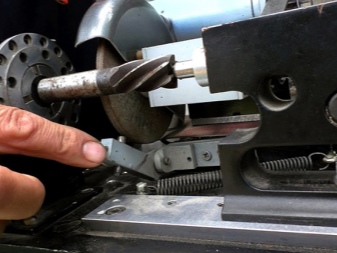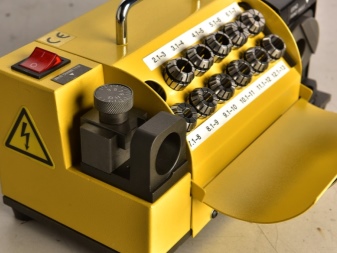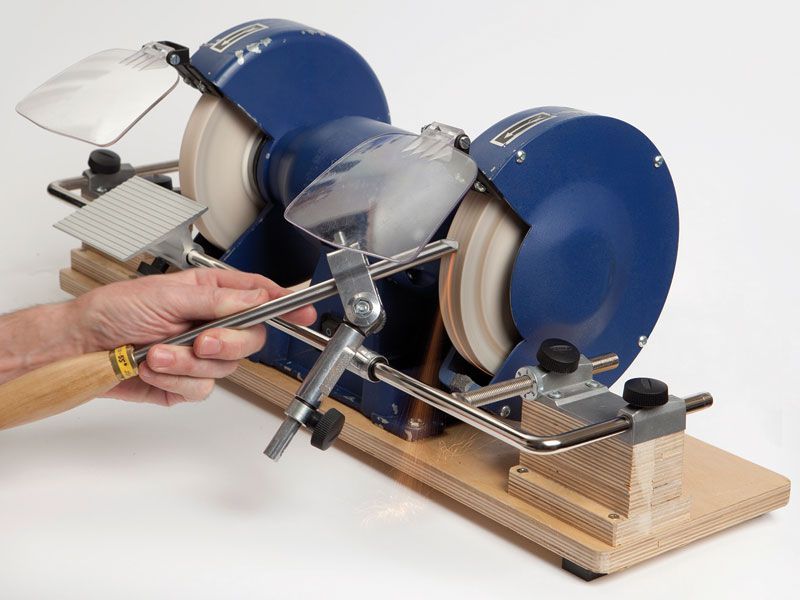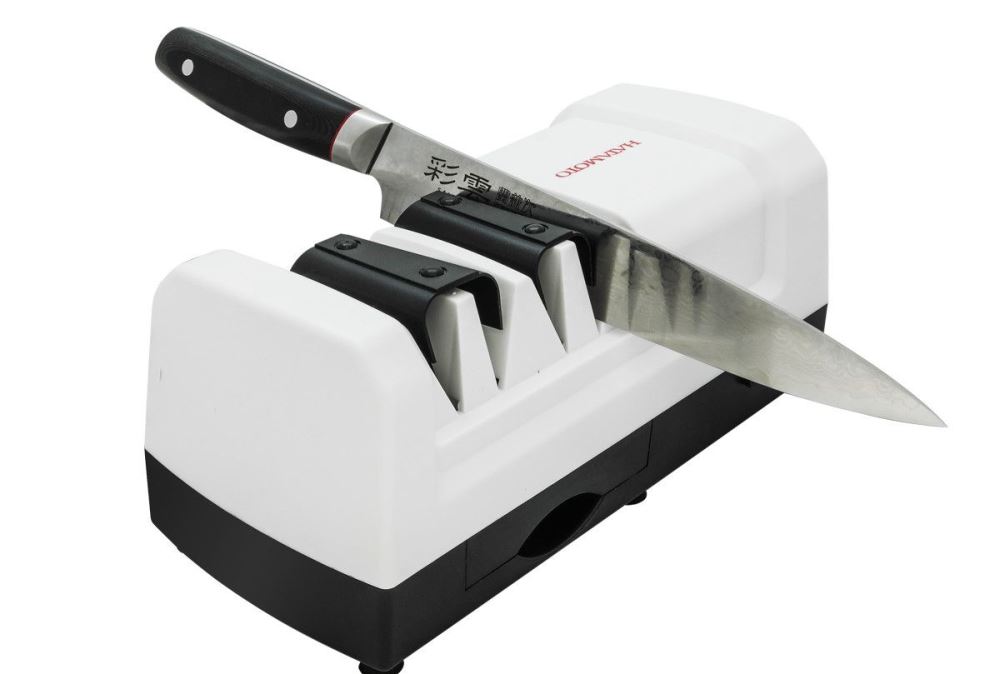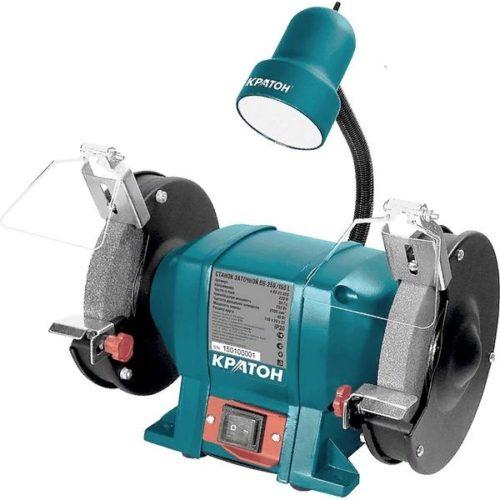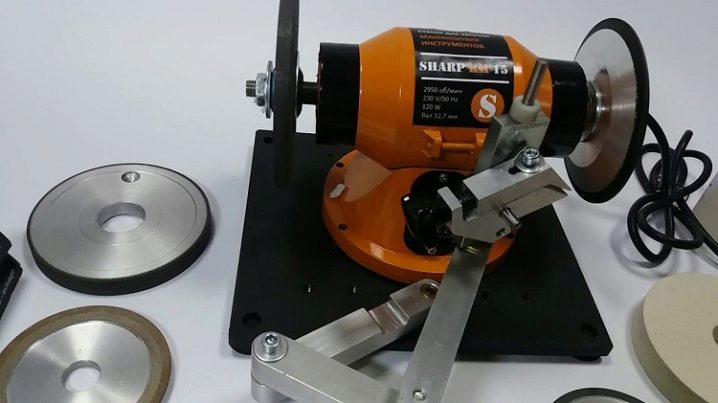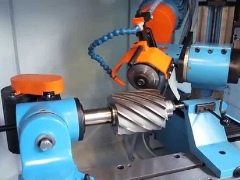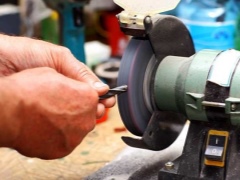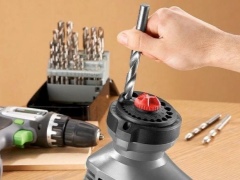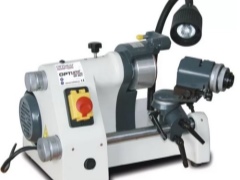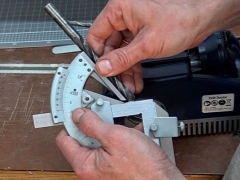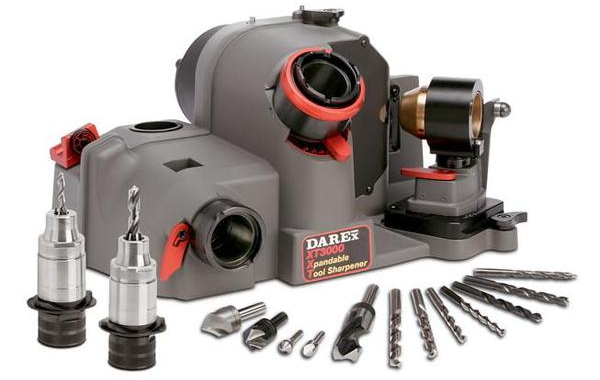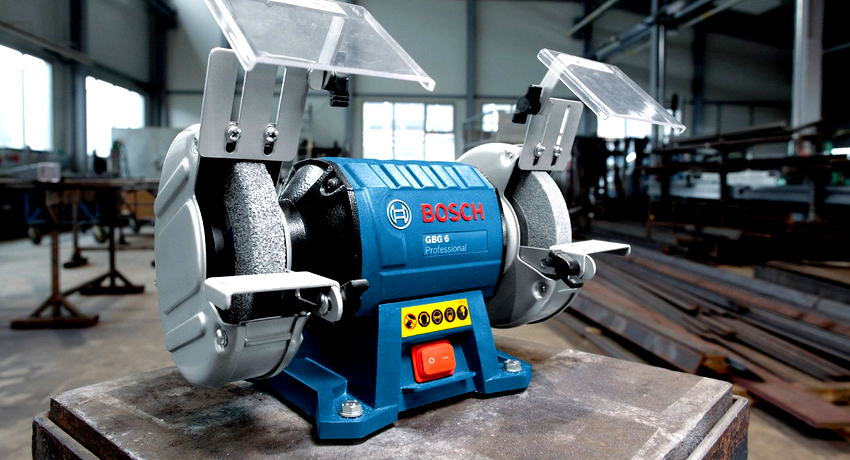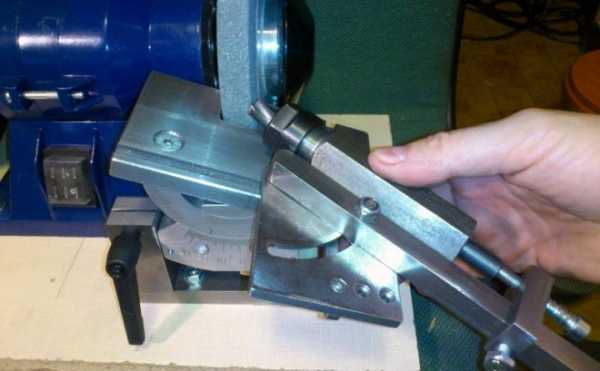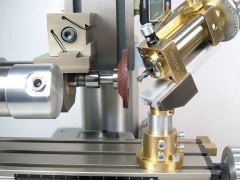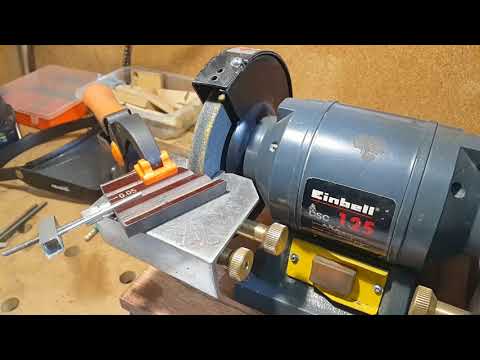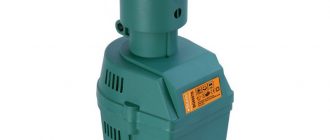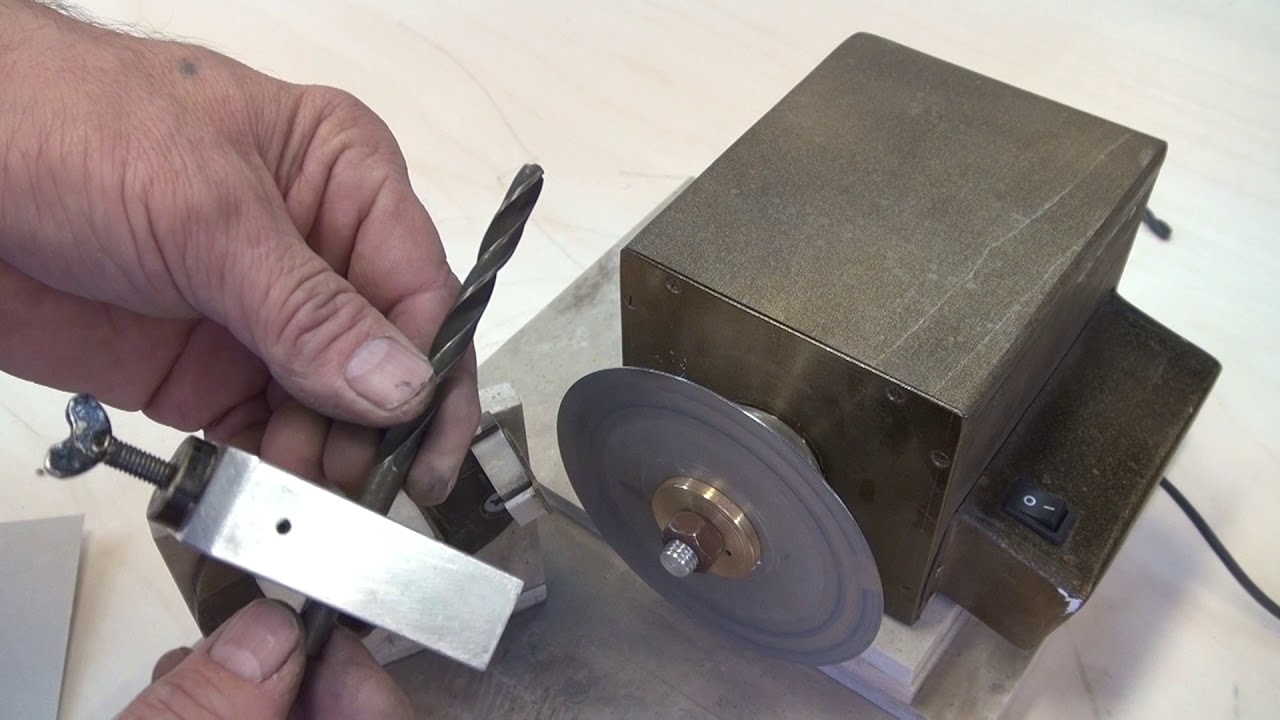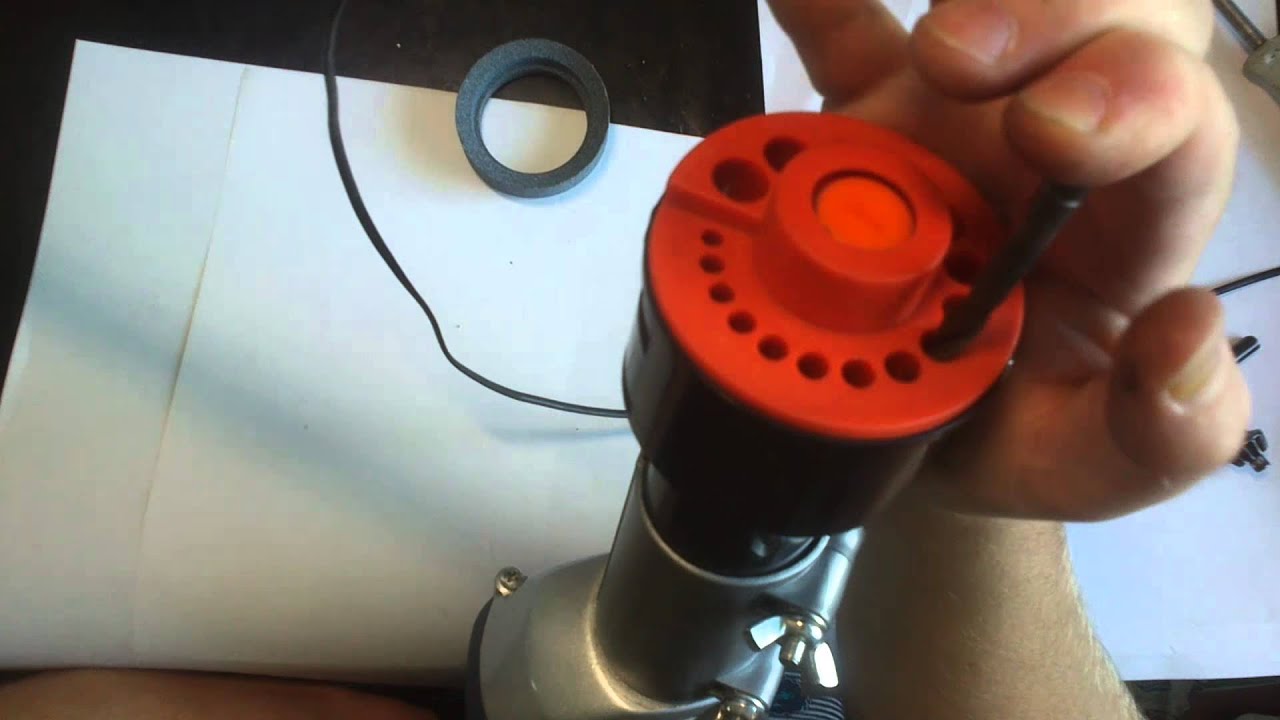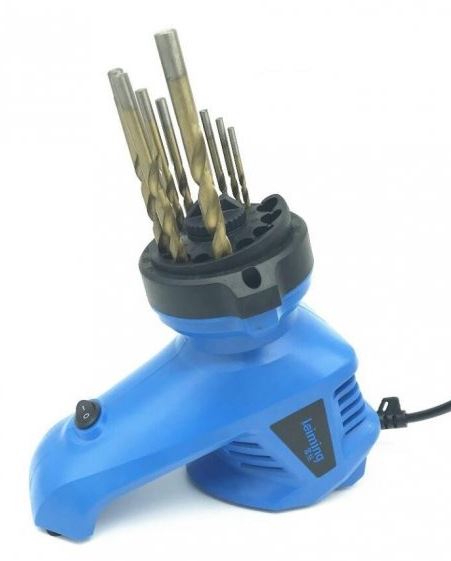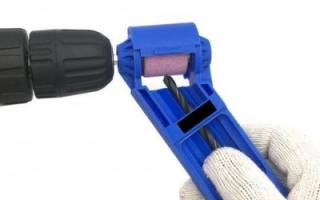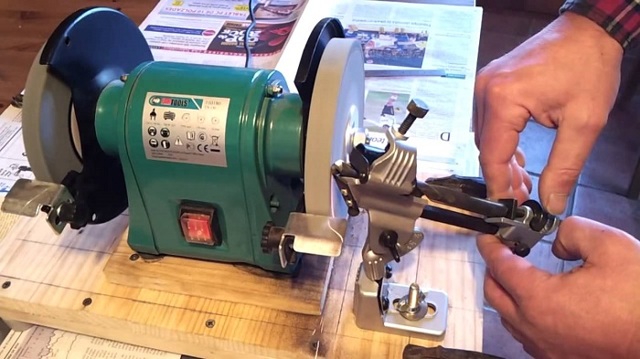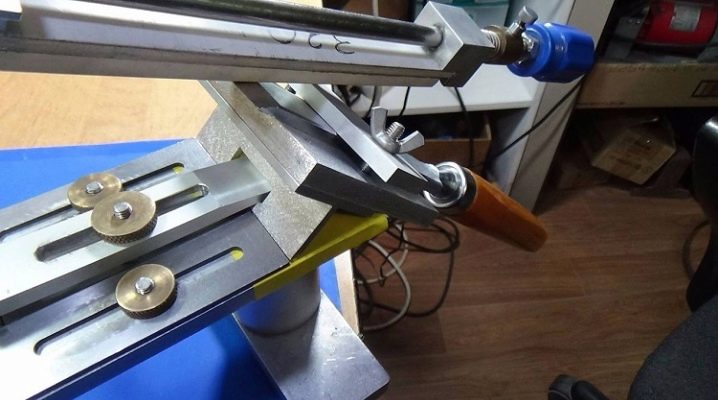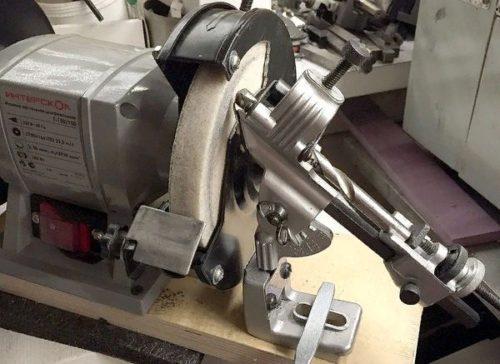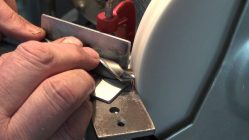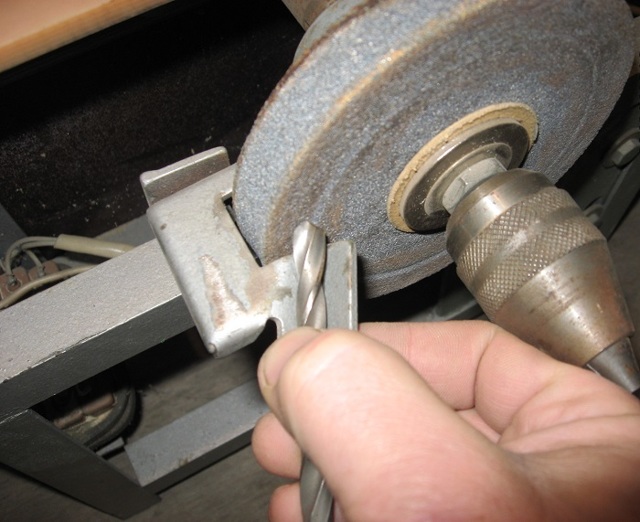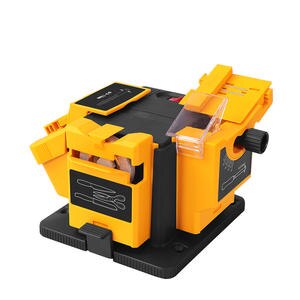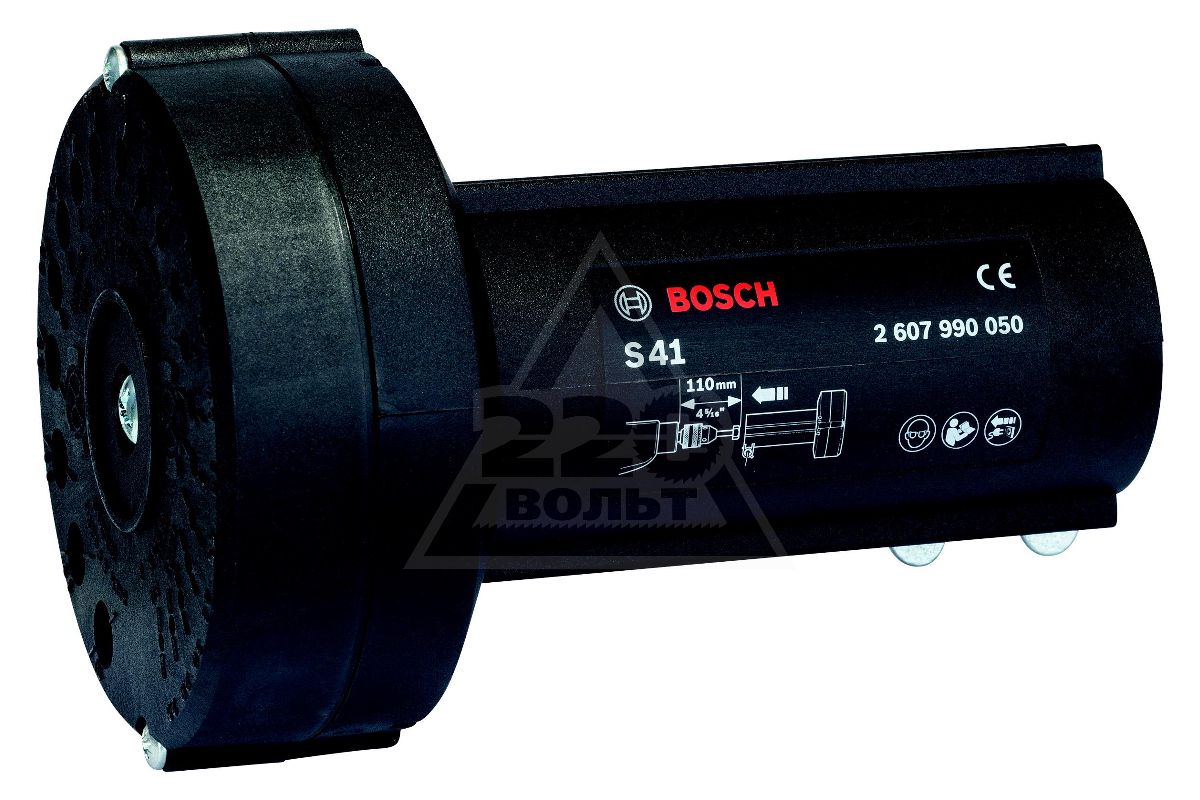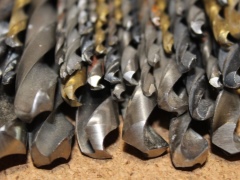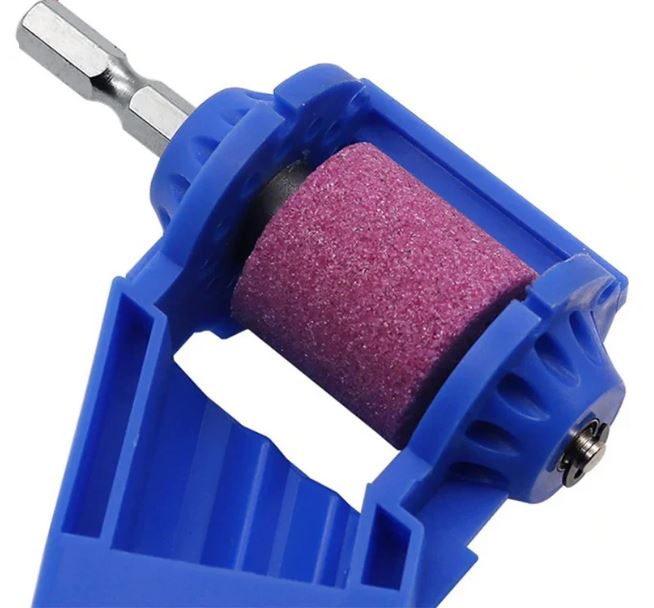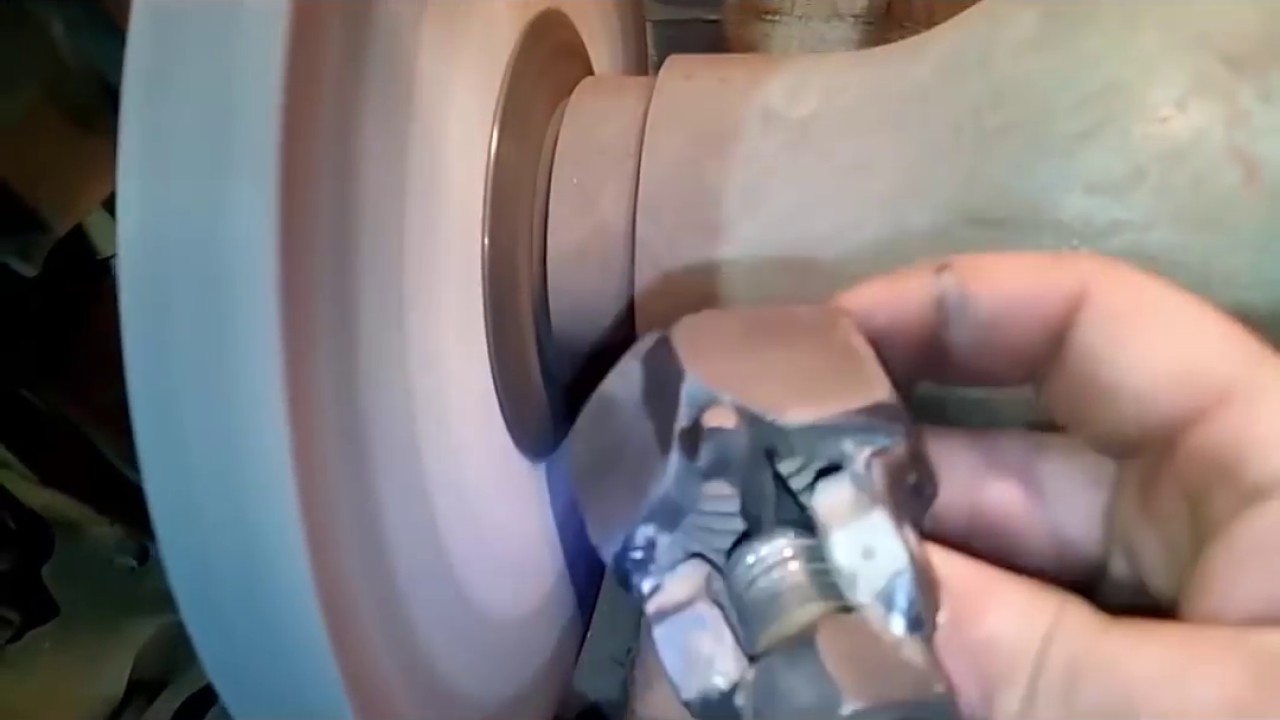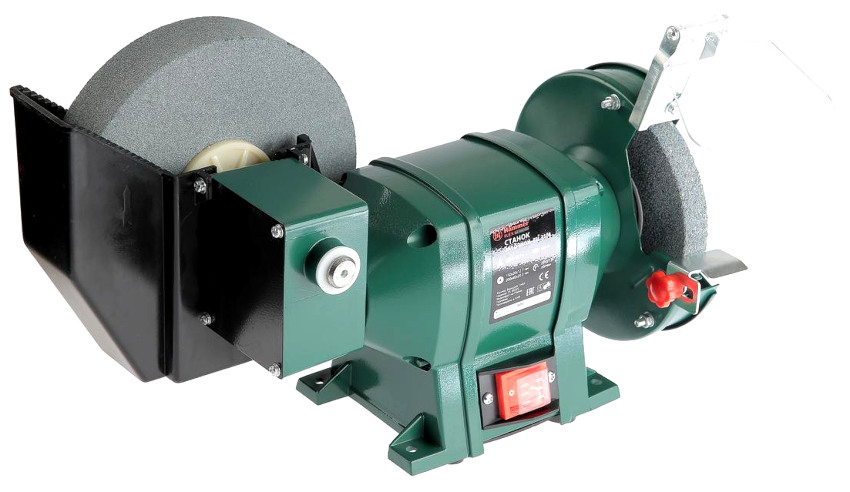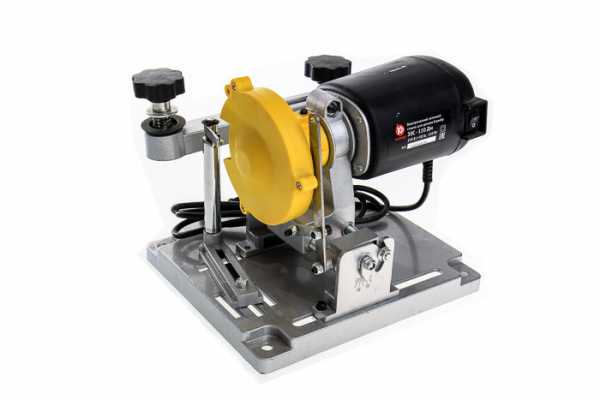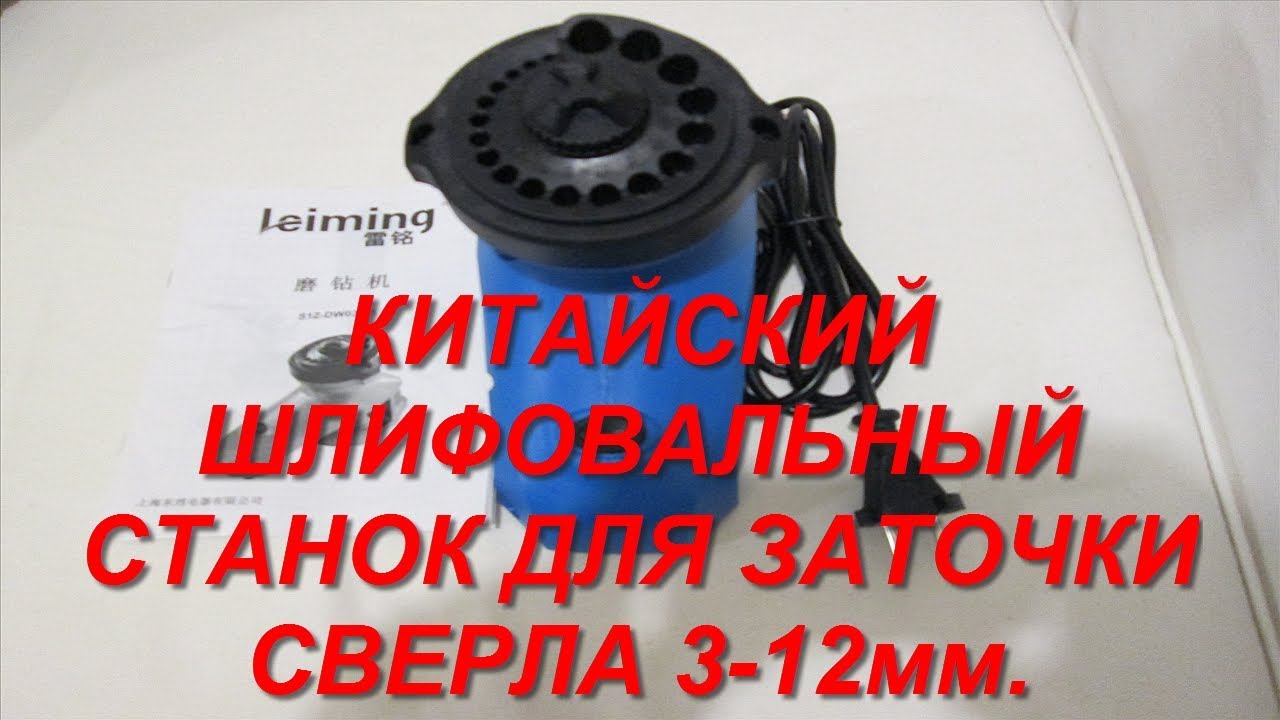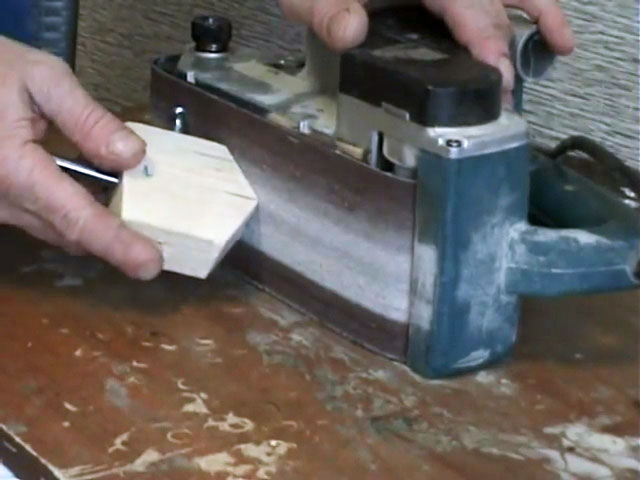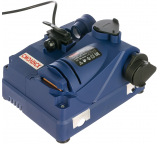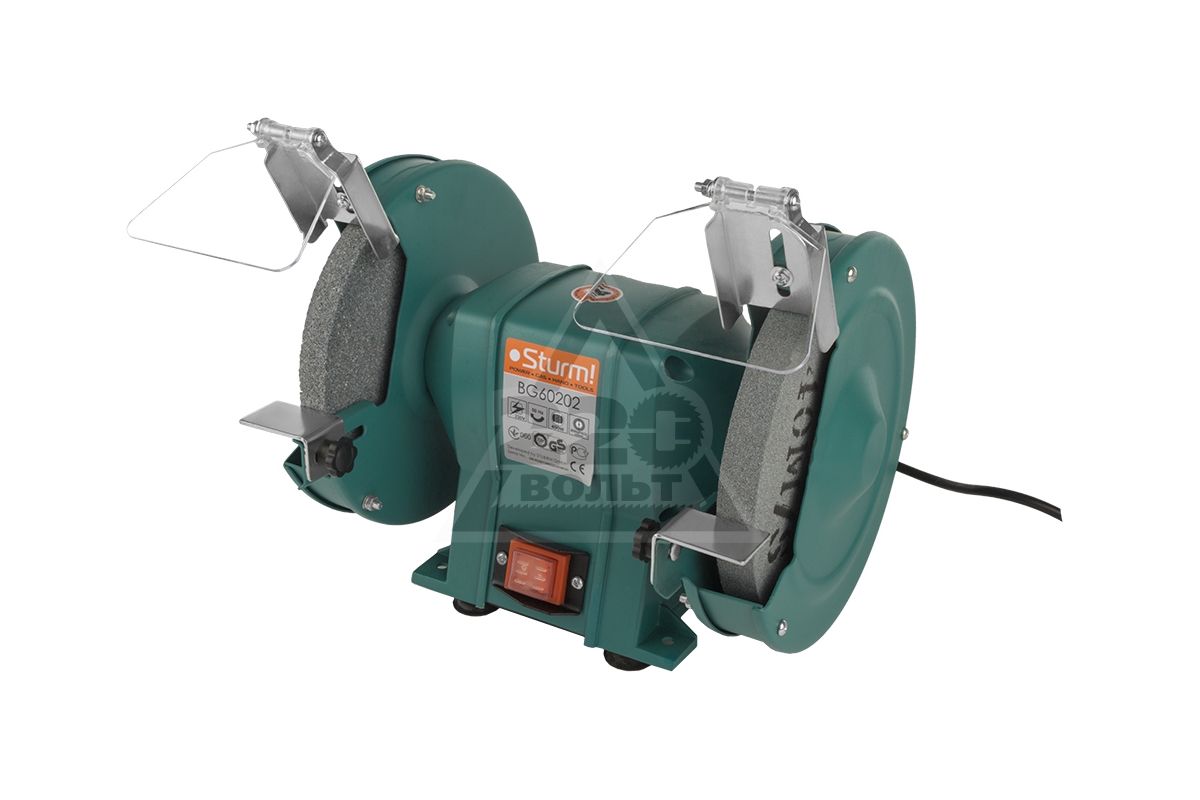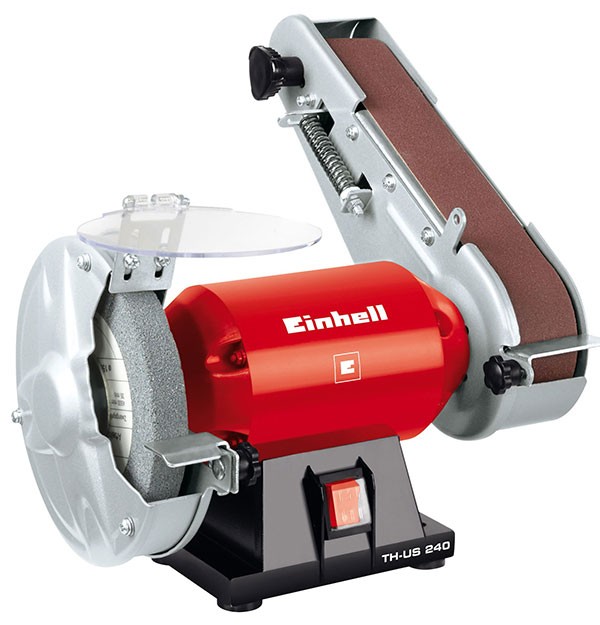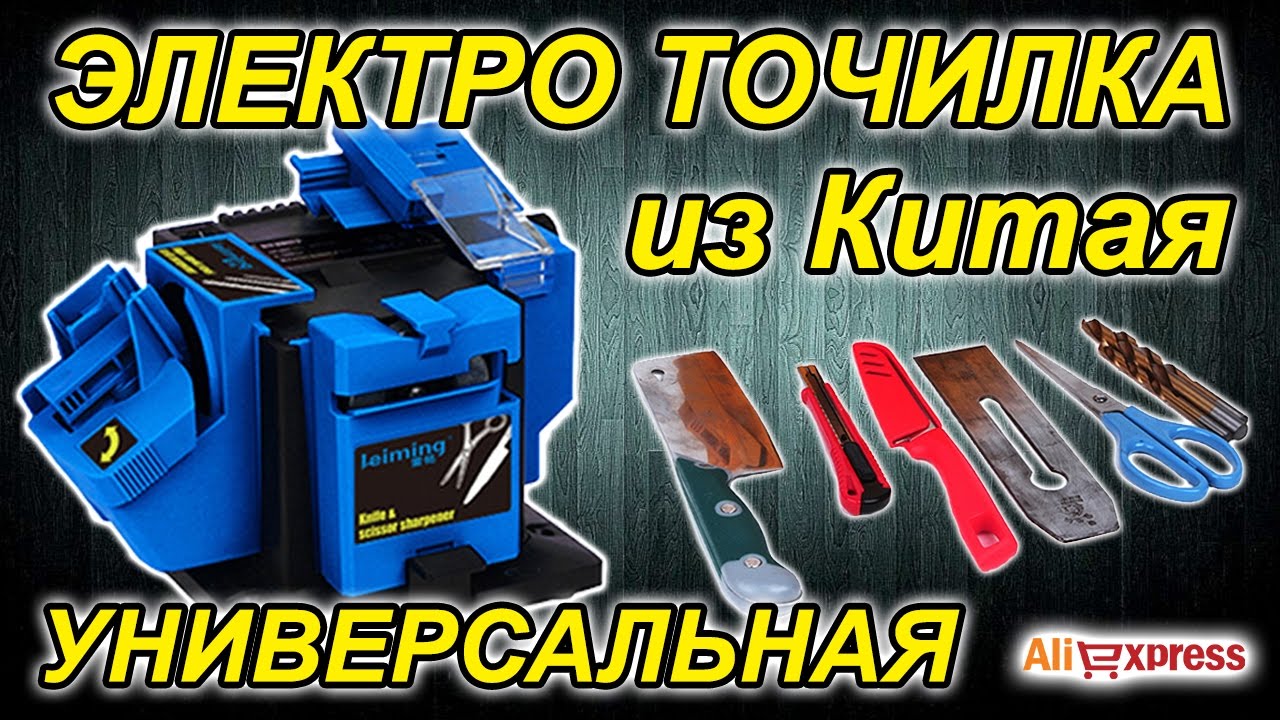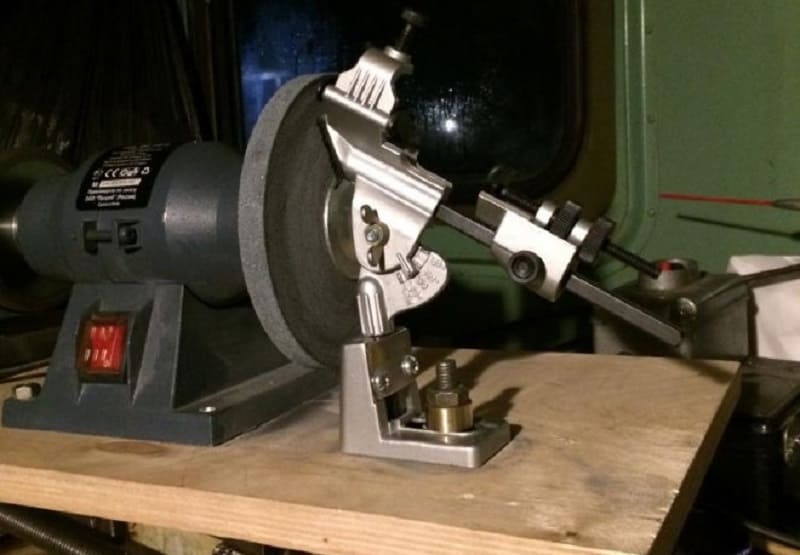ELITECH CT 300PC
Main characteristics:
- Engine power - 300 W
- Circle rotation speed - 2850 rpm
- Disc diameter - 150 mm
- Landing diameter - 20 mm
Body and base. This combination grinder has a cast body with a wide base with rubber feet for good stability. There are holes for rigid fixation in a stationary position. Weighing 10 kg the model is quite overall 435x390x240 mm.
Design features. The energy source here is a 300 W asynchronous electric motor rotating at a frequency of 2850 rpm. On the left side, an abrasive wheel with a size of 150x20 mm with a 32 mm bore hole is attached to it. On the right, there is a grinder with a grinding belt of not the most popular size of 50x686 mm for processing small parts with flat surfaces, which makes it possible to somewhat expand the functionality of the device. There is a small bath for wetting the workpieces.
Convenience of work and safety. All rotating parts are equipped with guards and spark arrestors. Access to the points of attachment of consumables is through removable covers with manual locks. There is a branch pipe for connecting a vacuum cleaner. In the area of the grinding wheel, a transparent glass with a magnifying lens and a tool stop with an inclined groove for sharpening drills are attached. A movable luminaire with an LED lamp is provided for local illumination. The start button is equipped with a key to prevent unintentional activation and child protection.
ELITECH CT 300PC device.
1. Protective cover. 2. Sanding belt 3. Protective shield 4. Grinding wheel.
5. Stop. 6. Machine switch 7. Cooling tank 8. Foundation. 9. Lamp.
10. Screw for fastening the protective casing. 11. Belt adjustment screw 12. Tensioner drum retaining screw.
Pros of ELITECH CT 300PC
- Multifunctionality.
- Sophisticated design.
- Backlight.
- Connection to a dust extraction system.
- Manual setting.
- Convenient stop for the sharpened tool.
- Regular bath.
- Low cost.
Cons of ELITECH CT 300PC
- It is difficult to find a suitable sanding belt.
- High noise level.
Rating of the best electric grinders
Universal grinding machines with wheels Ø125 and Ø150 mm
The most popular among home users are sharpeners with a drive power of 150 to 300 W and abrasive wheel diameters of 125 and 150 mm. The weight and dimensions of such machines allow them to be installed on a table, a wide windowsill or a small workbench. Most of them are equipped with circles of different grain size and have cords of 2 m or more. The table below shows the most popular machines of this type, among which "Caliber" stands out for its power and low price.
| № | Name | P (W) | S (rpm) | Circle Ø (mm) | Weight, kg) | Price (thousand rubles) |
|---|---|---|---|---|---|---|
| 1 | "Whirlwind" TS-150 | 150 | 2950 | 125 | 4,4 | 1,9 |
| 2 | Interskol T-150/150 | 150 | 2950 | 150 | 6,1 | 3,2 |
| 3 | "Whirlwind" TS-200 | 200 | 2950 | 150 | 5,2 | 2,3 |
| 4 | Makita GB 602 | 250 | 2850 | 150 | 9,2 | 7,5 |
| 5 | Sturm BG6015P | 300 | 2950 | 150 | 8,9 | 3,2 |
| 6 | "Caliber" TE-150/300 | 300 | 2950 | 150 | 7,9 | 2,1 |
The ZUBR combined machine tool ZTShM-150 / 686L (see photo below) belongs to the same group, which has a Ø150 mm circle on the left spindle, and a console with a 50 × 686 mm sanding belt on the right spindle. The weight of this model is 7.2 kg, the drive power is 250 W, and the price is 4 400 rubles.

Universal grinding machines with wheels Ø200 mm and more
| № | Name | P (W) | S (rpm) | Circle Ø (mm) | Weight, kg) | Price (thousand rubles) |
|---|---|---|---|---|---|---|
| 1 | "Whirlwind" TS-400 | 400 | 2950 | 200 | 9,2 | 3,7 |
| 2 | Interskol T-200/350 | 350 | 2950 | 200 | 11,8 | 5,1 |
| 3 | Elitech CT 600C | 600 | 2850 | 200 | 14,3 | 7 |
| 4 | Makita GB 801 | 550 | 2850 | 205 | 19,8 | 12,8 |
| 5 | "Ankor Corvette Expert" 485 | 750 | 2850 | 250 | 26 | 9,6 |
The most unusual model in this group is the Interskol electric grinder, which with Ø200 has a drive power of only 350 W, but at the same time weighs almost 12 kg. Another interesting sample is the Dexter 400 W 200 mm sharpener, widely represented on various Internet sites and in retail chains and having a completely democratic price of 3,950 rubles.
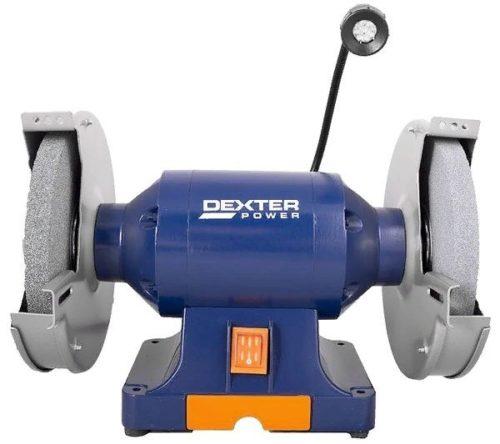
Specialized sharpening machines
| № | Name | Note |
|---|---|---|
| 1 | Grinding machine Sturm BG6010S | Sharpening of drills Ø 2 ÷ 10 mm, knives, planers with a width of 6 ÷ 51 mm, scissors, household knives |
| 2 | Sharpening machine "Energomash" TS-6010S | Sharpening of drills, knives, scissors, carpentry and metalwork tools |
| 3 | Sharpening machine "DIOLD" MZS 0.3 | Drill sharpening Ø 3 ÷ 10 |
In addition to the above model, "DIOLD" produces another one - MZS 02, which is designed for sharpening drills with a diameter of 3 to 13 mm. All these devices are household devices, have low accuracy and low productivity. Therefore, small enterprises specializing in sharpening locksmith and machine tools prefer to purchase professional machines. The price of such equipment reaches 400 thousand rubles, therefore in the CIS countries used Vitebsk grinding machines 3В642 are especially popular, which in the secondary market, depending on the state, cost from 35 to 75 thousand rubles.
GSC
| GSC GS - 1 for twist drills (2-13 mm) | Drill diameter 2-13 mm |
Apex angle 90°-140 ° |
In stock |
63 336 q 1,772 BYN |
||
| GSC GS - 1 A for twist drills (2-13 mm) | Drill diameter 2-13 mm |
Apex angle 90°-140 ° |
In stock |
107 520 q 3 009 BYN |
||
| GSC GS - 3 for twist drills (2-13 mm) | Drill diameter 2-13 mm |
Apex angle 118°-135 ° |
In stock |
80 640 q 2 256 BYN |
||
| GSC GS - 5 for twist drills (3-13 mm) | Drill diameter 3-13 mm |
Apex angle 165° — 180 ° |
In stock |
99 204 q 2 776 BYN |
||
| GSC GS - 7 for sheet metal drills and twist drills (3-13 mm) | Drill diameter 2-13 (spiral) mm |
Apex angle 90 ° - 140 (spiral) ° |
In stock |
148 176 q 4 146 BYN |
||
| GSC GS - 8 for twist drills (3-13 mm) | Drill diameter 2-13 (spiral) mm |
Apex angle 90°-140 ° |
In stock |
152 964 q 4 280 BYN |
||
| GSC GS - 9 for twist drills (2-13 mm) | Drill diameter 2-13 (spiral) mm |
Apex angle 90°-140 ° |
In stock |
152 964 q 4 280 BYN |
||
| GSC GS - 13 for twist drills (3-16 mm) | Drill diameter 3-16 mm |
Apex angle | In stock |
107 520 q 3 009 BYN |
||
| GSC GS - 18 for twist drills (3-13 mm) | Drill diameter 3-13 mm |
Apex angle 135 ° |
In stock |
84 420 q 2 362 BYN |
||
| GSC GS - 19 for twist drills with 2-plane relief (3-13 mm) | Drill diameter 3-13 mm |
Apex angle 135 ° |
In stock |
152 964 q 4 280 BYN |
||
| GSC GS - 20 for twist drills (2-20 mm) | Drill diameter 2-20 mm |
Apex angle 90°-140 ° |
In stock |
124 908 q 3 495 BYN |
||
| GSC GS - 21 for twist drills (12-26 mm) | Drill diameter 12-26 mm |
Apex angle 90°-140 ° |
In stock |
171 108 q 4 788 BYN |
||
| GSC GS - 22 for sheet metal drills (12-26 mm) | Drill diameter 12-26 mm |
Apex angle 160°-180 ° |
In stock |
84 420 q 2 362 BYN |
||
| GSC GS - 24 for twist drills (3-12 mm) | Drill diameter 2-13 mm |
Apex angle 90°-140 ° |
In stock |
231 504 q 6 478 BYN |
||
| GSC GS - 25 for twist drills (3-25.4 mm) | Drill diameter 3-25.4 mm |
Apex angle 90°-140 ° |
In stock |
143 220 q 4 008 BYN |
||
| GSC GS - 29 for twist drills and twist drills (12-26 mm) | Drill diameter 12-26 mm |
Apex angle 90°-140 ° |
In stock |
243 684 q 6 819 BYN |
||
| GSC GS - 34 for twist drills (12-34 mm) | Drill diameter 12-34 mm |
Apex angle 90°-140 ° |
In stock |
182 952 q 5 120 BYN |
OPTIMUM
| GQ-D13 for twist drills | Drill diameter | Apex angle |
Coming soon |
5 237 q 146 BYN |
||
| DG 20 Vario for twist drills | Drill diameter | Apex angle |
Coming soon |
73 853 q 2 066 BYN |
||
| GH 10T for twist drills | Drill diameter | Apex angle | In stock |
47 156 q 1 319 BYN |
||
| GH 15T for twist drills | Drill diameter | Apex angle |
Coming soon |
130 560 q 3 653 BYN |
||
| GH 20T for twist drills and tools | Drill diameter | Apex angle | In stock |
81 514 q 2 281 BYN |
Important features and options
If it is necessary to carry out processing at lower speeds (for example, wet finishing grinding or polishing), gearboxes are used that reduce the number of revolutions of the grinding wheel to 120 ÷ 150 rpm. If you need sampling or grinding at high speeds with precise speed control, the grinding machines use AC collector motors with frequency or amplitude control of the speed of rotation. This technical solution, in particular, is used in sharpeners with an additional flexible shaft. The photo below shows an electric grinder with a reduction gear and a "wet" circle turned to reduce the size parallel to the drive axis.
Device and principle of operation
At its core, the standard design of a drill grinder is simple enough that the equipment works almost flawlessly and boasts a maximum service life. Modern sharpeners are made up of these components.
- The body of the device, which houses its power plant (electric motor). By the way, the power of the latter is chosen taking into account what kind of hardness materials will be processed on the machine. In parallel, it should be borne in mind that the speed of rotation of the sharpening elements directly depends on the power of the motor, and therefore the time spent on performing the necessary work.
- Abrasive wheels parallel to each other, which can be made of different materials. So, for processing drills made of hard alloys, as a rule, diamond sharpening elements are used. Regardless of the material, their diameter varies in the range of 125 - 250 mm, the key points here are the dimensions of the seats (most often this parameter is 32 mm), as well as the grit size of the abrasive. The latter is selected taking into account the state of the drill and the stage of its sharpening.
- Grinding belts and accessories, which are most often found on universal models of sharpening machines.
- A protective shield, which is a transparent shield in the form of a plate. The presence of this element is dictated by the requirements of safety regulations and is mandatory.
- Equipment start and stop buttons.
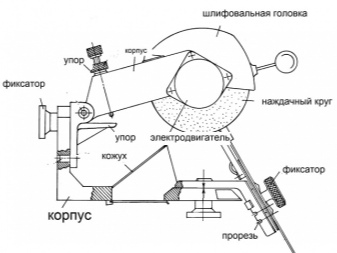

Experienced craftsmen advise, when choosing machines, to give preference to models equipped with asynchronous power plants. Their main competitive advantages include, first of all, maximum resistance to voltage drops in the network.
Among other things, it should be taken into account that sharpeners, oriented to use in everyday life, small workshops and small businesses, are distinguished by a rigid attachment of abrasive elements. In this case, the movable part is a rig with a fixed drill.


Which grinder is better to buy for the home
A sharpening machine is a necessary equipment for a master who is engaged in joinery, carpentry, turning or locksmith's work. Usually it consists of one or two discs of different grain size, mounted directly on the motor shaft.
Sometimes a reduction gear, a wetting system, a sanding belt or a flexible drive for engraving are added to the design. The safety and convenience of work is facilitated by a protective casing, a transparent screen, illumination, and a support platform with an adjustable angle of inclination. Consider what characteristics an electric emery should have, depending on the intensity of operation and the nature of the operations performed.
What power should be depending on the upcoming use
The power determines the maximum load on the electric motor, which will not lead to overheating and failure. It is still not worth chasing the limits for equipment that will be operated in a home workshop.
There are inexpensive and compact machines on the market for 150-250 W, suitable for sharpening knives, chisels, drills and other small cutting tools. More powerful models may be required for sharpening axes, scythes and other large objects.
How to determine the maximum speed
With an increase in the speed of rotation of the grinding wheel, the productivity of the machine increases, but the risk of overheating of the sharpened part increases with the danger of breaking the internal structure and reducing the hardness of the material.
For grinding high-quality steel, the frequency of 2700-3000 rpm is considered optimal. It is better to perform processing of thin edges at reduced conditions. When sharpening particularly hard alloys (for example, drill drills) with fine-grained diamond discs, 10-15 thousand rpm may be required.
How to choose the diameter of the circle
Grinding wheels of large diameter have an increased resource and are more inertial, which ensures smooth running, uniform load on the engine and high quality machining of large-sized parts.
They are more expensive, and when installed on a machine with a low-power motor, they can cause damage. In a home workshop, medium and small discs are usually used.
Wheels for a grinding machine.
What you need to know about the rim diameter
For correct installation, the size of the wheel bore must match the diameter of the shaft. This parameter usually increases in proportion to the power and maximum rotational speed of the machine. Some models are equipped with adapter devices, which gives additional freedom in the choice of drives.
All other things being equal, equipment with a large shaft should be preferred. It better withstands the stresses associated with unbalanced discs, less vibrations and contributes to high machining accuracy.
What affects the thickness of the circle
When sharpening a small tool, it is convenient when the width of the circle is slightly larger than the cutting edge. Larger discs grind down longer and are less prone to imbalance, but this parameter should not be thoughtlessly overestimated. The mass of such a part must correspond to the engine power.
The specifics of sharpening drills with different shapes of the cutting part
The first sign that the drill needs sharpening is the characteristic squeak at the beginning of its work. This indicator cannot be neglected, because it can have further negative consequences:
- the edge of the drill will begin to crumble;
- the engine will be overloaded;
- burrs will appear on the treated surface.
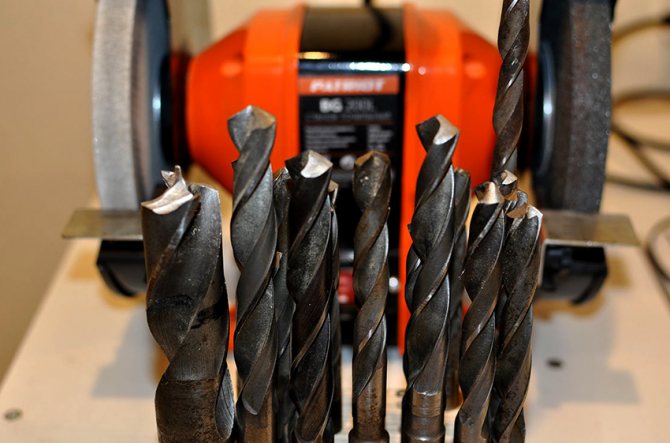
First of all, the sharpening method will depend on the shape of the cutting part of the drill.
The question of how to sharpen the drill correctly will be considered using the example of a spiral version. The sharpening method depends on the shape that you want to give the cutting part. The type of sharpening can be as follows:
- single-plane;
- two-plane;
- cylindrical;
- conical.
In the course of single-plane sharpening, the drill is simply placed parallel to the abrasive wheel, it does not move. In this simple way, drill bits up to 3 mm can be sharpened. Two-plane sharpening is done in a similar way.
Conical sharpening is somewhat more difficult. The drill should be taken with both hands: with the left - closer to the tapered working part, with the right - by the shank. It is necessary to press the tool against the end part of the grinding wheel with the cutting edge and the back plane. Swing the drill with your right hand. Cylindrical sharpening is performed in a similar way.

The conical drill is sharpened from the front side of the grinding wheel
How to sharpen a drill correctly: possible errors and their prevention
Despite the large amount of information on how to sharpen drills for metal, even with sufficient theoretical and sometimes practical knowledge, many make a number of mistakes.It is not difficult to predict the consequences: when turning, the cutting edge crumbles, the tool overheats, the cut has dimensional errors, roughness and irregularities on the processed surfaces are possible.
Typical errors when sharpening drills include the following deviations from the norm:
- Different lengths of cutting edges. The drilling center is offset from the tool axis. A drill sharpened in this way will experience a runout, it will be extremely difficult to get exactly in the center. Most often, such drills break during operation.
- Asymmetry of angles with a precisely aligned center. After such processing, the tool will have only one working edge. The drill will heat up, and the hole made by it will acquire a diameter larger than that of the tool.

Errors when sharpening drills are made not only by beginners, but sometimes even by professionals
The errors listed above are most of all the result of an incorrectly designed grinding device. And here again it is worth returning to the drawings. A do-it-yourself drill sharpener should have a functional sharpening angle holder. Its use will ensure correct processing of cutting surfaces.
Indicators of the magnitude of the angles of sharpening drills for metal
Regardless of the device on which sharpening is performed, the process must be controlled. In this regard, the most advanced machine tools with electronic control. The possibility of adjustment on electromechanical devices also allows for high-quality processing.
A very important indicator is the size of the sharpening angle. It is not the same for different materials, since the latter differ in the level of density and the specifics of the structure.
A table containing information on the correct sharpening angles of drills:
| Processed material | Sharpening angle |
| Steel, cast iron, carbide bronze | 115-120° |
| Soft bronze, brass alloys | 125-135° |
| Red copper | 125° |
| Aluminum and soft alloys based on it | 135° |
| Granite, ceramics | 135° |
| Wood of any species | 135° |
| Magnesium and its alloys | 85° |
| Silumin | 90-100° |
| Plastic, textolite | 90-100° |
It is convenient to control the correct sharpening of drills using templates.
Drill sharpening machine
In any machine designed for sharpening a drilling tool, three main working components are necessarily present: a rotating abrasive wheel, a device for fixing the drill at specified angles and a device for sharpening it. Different types of machine implement these functions in different ways. But all of them are united by the fact that the drill is set in length and at the main corners outside the working area. In grinding and grinding machines intended for use in home workshops, repair shops and in small enterprises, during the working feed, the tooling with the tool moves to a linearly stationary abrasive disc. And in universal grinding machines for industrial use, working movements are usually performed with a grinding wheel.
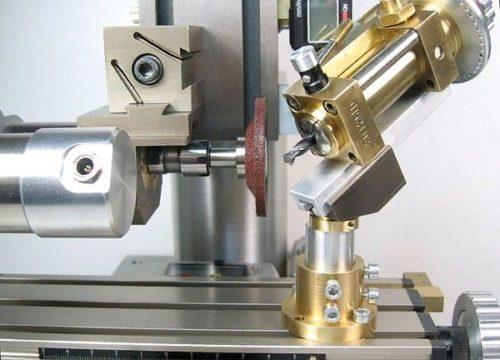
Traditional sharpening tooling of the machine usually includes a stand with a slide, in which the drill is clamped (see photo above). Such a device is located next to the abrasive wheel and ensures the positioning of the working surfaces at predetermined angles, as well as the execution of the working feed. Simplified designs with the same layout are used both in everyday life and in small industries. Recently, however, machines have become increasingly popular in which special chucks are used as equipment for setting and feeding the drill. Although such grinding equipment is available in various versions, from industrial applications to household appliances, the principle of operation is the same for all of its varieties. At the first stage, the chuck with the drill is installed in a special bore hole, where the feed depth and required angles are set.Then the tuned chuck is inserted into the working bore, located opposite the abrasive wheel, and manually rotated half a turn until the drill is completely sharpened. The figure below shows the design of the simplest machine of this type of the well-known brand Drill Doctor.

Species overview
Most of the described devices are automated equipment with a narrow specialization. In other words, such installations are only intended for turning drills. They are classified mainly taking into account the scope and the following two categories are distinguished.
Industrial (professional), with increased power and intended for sharpening drills that are constantly used, therefore, often dull. We are talking about equipment designed for intensive operation at maximum loads in the conditions of enterprises and performing sharpening in a fully or semi-automatic mode.

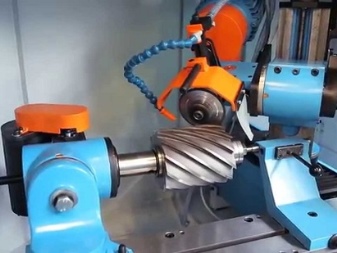
Also, the described devices are divided into narrowly targeted and universal. The latter differ from their specialized "counterparts" by the presence of additional devices that allow sharpening not only drills.
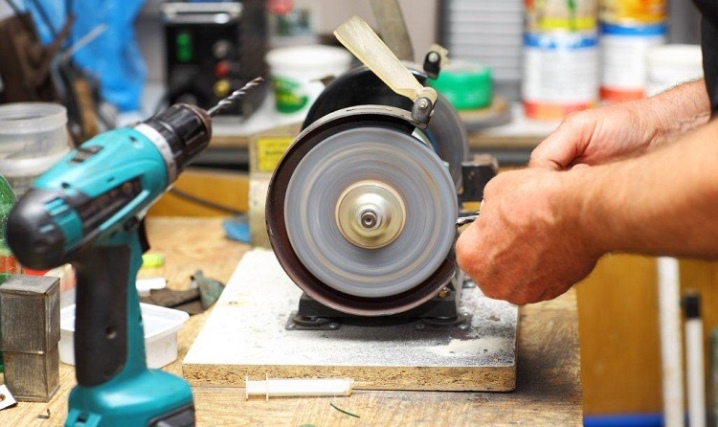
Household
Of course, at home, ordinary emery can be successfully used to sharpen a small diameter drill. However, the use of modern models of specialized equipment will greatly simplify and speed up the process. It will also improve the quality of tool processing. In this case, we are talking about the following clear advantages:
- the ability to operate when connected to a conventional power supply;
- increased productivity;
- maximum simplicity of design and operation;
- increased sharpening accuracy;
- affordable cost;
- compact size and light weight;
- a convenient and intuitive control system for the apparatus, which provides, among other things, a smooth change in the rotation speed.
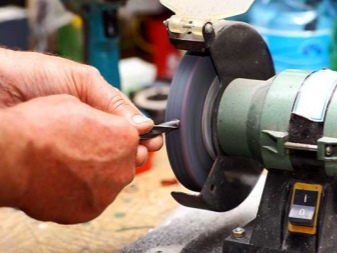

In the overwhelming majority of cases, household models of the devices under consideration are designed to work with spiral drills for metal and wood, made of high-speed steel. At the same time, a certain range of diameters is structurally incorporated in them. In addition, many machines are equipped with additional diamond wheels for machining carbide inserts. As a rule, household units are focused on drills with a taper angle from 90 to 140 degrees and creating a relief with a sharpening of the transverse cutting edge.
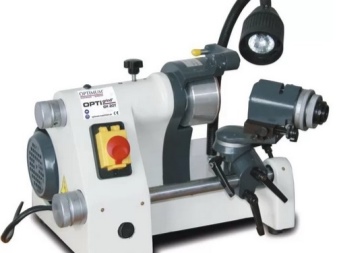
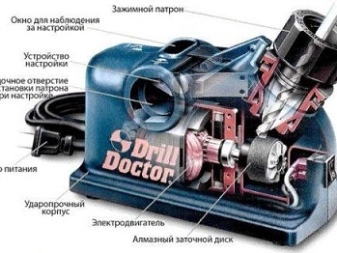
However, specific models for the following types of metal drills can also be found on sale:
- having a two-plane backing;
- left;
- three-toothed;
- with increased productivity.
In accordance with numerous reviews, the best option for a household machine will be models equipped with a universal chuck. Also, in this case, we are talking about units that are equipped with sets of cartridges.
Industrial
As a rule, professional models belong to the category of universal sharpening machines. They differ from household counterparts in larger dimensions, as well as in power and stationary installation. Accordingly, such a power determines the corresponding energy consumption, as well as the noise level during operation. Taking into account all of the above, such equipment is most often placed in separate rooms, and when performing work, they use noise protection means. On the domestic market, industrial equipment is represented by model lines of both Russian and foreign brands.
In addition, on sale you can find products of companies representing the Middle Kingdom, produced under domestic brands. In the overwhelming majority of cases, models of grinders are offered for processing drills and cutters, the diameter of which is up to 30 millimeters or more. Most of the professional samples of the described equipment have a horizontal layout. Although vertical devices are found, they are much less common.The delivery set of industrial machines includes a set of collets designed for fixing the tool. In this case, the positioning accuracy is 10-20 microns.
